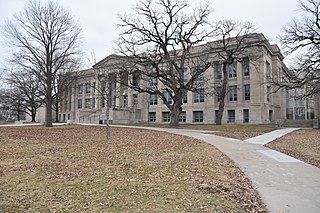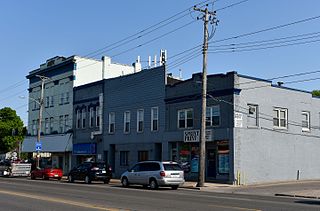 | |
| Type | Not-for-profit Private University |
|---|---|
| Active | 1890–1918 |
| Location | , , |
| Campus | Urban |
Highland Park College was a college located in Des Moines, Iowa. [1]
 | |
| Type | Not-for-profit Private University |
|---|---|
| Active | 1890–1918 |
| Location | , , |
| Campus | Urban |
Highland Park College was a college located in Des Moines, Iowa. [1]
Founded by a local business syndicate, [2] Highland Park opened its doors in 1890. [3] At the time, Highland Park was an emerging northern suburb of the capital city. Enrollment climbed in its early years before a dip following the Panic of 1893; enrollment later stabilized around 2,000 students.
In 1911, the previously independent college was sold to the Presbyterian Church.
In 1918, the college merged with Des Moines College and Central University of Iowa to form a new Des Moines University on the Highland Park campus. That successor institute closed in 1929; today, the campus site has a shopping mall.

Des Moines is the capital and most populous city in the U.S. state of Iowa. It is the county seat of Polk County with parts extending into Warren County. It was incorporated on September 22, 1851, as Fort Des Moines, which was shortened to "Des Moines" in 1857. It is located on, and named after, the Des Moines River, which likely was adapted from the early French name, Rivière des Moines, meaning "River of the Monks". The city's population was 214,133 as of the 2020 census. The six-county metropolitan area is ranked 81st in terms of population in the United States, with 709,466 residents according to the 2020 census by the United States Census Bureau, and is the largest metropolitan area fully located within the state.

Ankeny is a city in Polk County, Iowa, United States and a suburb of the state capital of Des Moines, as part of the Des Moines-West Des Moines, IA metropolitan statistical area. As of the 2020 census, the population of Ankeny was 67,887, making it the seventh most populous city in the state. It is one of the fastest-growing cities in Iowa. Currently, the city's incorporated area totals 29.14 square miles.

Des Moines University (DMU) is a private medical school in West Des Moines, Iowa. Founded in 1898, Des Moines University is the second oldest osteopathic medical school and the fifteenth largest medical school in the United States. DMU's three colleges—the College of Osteopathic Medicine, College of Podiatric Medicine and Surgery, and College of Health Sciences—offer nine academic degrees, including master's and doctorate degrees.

Des Moines Area Community College (DMACC) is a public community college in central Iowa. The college served 35,488 credit students and 29,021 noncredit students in 200 programs in 2019.

The Des Moines Independent Community School District is the largest public school district in Iowa. It is accredited by the North Central Association of Secondary Schools and Colleges and the Iowa Department of Education.

East High School, often locally referred to as East or East High, is a public secondary school located in Des Moines, Iowa, United States. East is the oldest high school in the Des Moines metro and is part of the Des Moines Public Schools. East is currently the seventh largest high school in the state by enrollment with 2,076 students.

The Lutheran School of Theology at Chicago (LSTC) is a seminary of the Evangelical Lutheran Church in America in Chicago, Illinois. LSTC is a member of the Association of Chicago Theological Schools (ACTS), a consortium of eleven area seminaries and theological schools. It shares the JKM Library and portions of its campus with McCormick Theological Seminary. LSTC is accredited by the Association of Theological Schools and regionally accredited by the Higher Learning Commission.
Vennard College was a non-denominational Christian college located in University Park, Iowa, located just outside of Oskaloosa, Iowa. It was announced on Nov. 12, 2008 that the college would close at the end of the 2008 fall semester due to a decline in enrollment and financial difficulty. The college held its final commencement on Nov. 22, 2008 and it is now closed.
Southwestern Community College (SWCC) is an American public community college with its main campus in Creston, Iowa. It also has centers in Red Oak, Iowa, and Osceola, Iowa. In addition to an arts and sciences program, SWCC offers career and technical education (CTE) degrees and certificates.

The Grand View Vikings are the athletic teams that represent Grand View University, located in Des Moines, Iowa, in intercollegiate sports as a member of the National Association of Intercollegiate Athletics (NAIA), primarily competing in the Heart of America Athletic Conference (HAAC) since the 2015–16 academic year. The Vikings previously competed in the defunct Midwest Collegiate Conference (MCC) from 1989–90 to 2014–15.
Des Moines University was an American college in Des Moines, Iowa, that operated from 1865 until 1929. It was established by members of the Baptist Church. It was originally located in an abandoned Lutheran college building at 15th and Pleasant near downtown Des Moines. It moved to College and 9th Avenues in 1884. In 1889, the school was renamed Des Moines College to better reflect its mission.

The Chautauqua Park Historic District is located on the north side of Des Moines, Iowa, United States. It has been listed on the National Register of Historic Places since 1990. It is part of the Suburban Development in Des Moines Between the World Wars, 1918--1941 MPS.

The College Corner Commercial Historic Business District, also known as the Highland Park Historic Business District at Euclid and Second, is located in the north-central section of Des Moines, Iowa, United States. It is located in the Highland Park neighborhood that also includes the Highland Park Historic Business District at Euclid and Sixth Avenues. The College Corner historic district has been listed on the National Register of Historic Places since 1998.

The Highland Park Historic Business District at Euclid and Sixth Avenues is located in the north-central section of Des Moines, Iowa, United States. It is located on the border of the Oak Park and Highland Park neighborhoods. The commercial historic district has been listed on the National Register of Historic Places since 1998. The Highland Park neighborhood also includes the College Corner Commercial Historic Business District.

The West Ninth Streetcar Line Historic District is located in the north-central section of Des Moines, Iowa, United States. The focus of the district is West Ninth Street from University Avenue on the south to Hickman Road on the north, which had a street car line that ran on it. It has been listed on the National Register of Historic Places since 1998. It is part of the Towards a Greater Des Moines MPS.

Frank E. Wetherell was an American architect in the Midwest U.S. state of Iowa who was active from 1892 to 1931. Frank Wetherell was educated in the Oskaloosa, Iowa schools, and went on to Iowa City where he first studied civil engineering at the State University of Iowa, then changed to the field of architecture. It appears that he began his professional career in Oskaloosa in 1892, at the age of twenty-two. Following his marriage in 1894 to Amy Loosley, the couple moved to Peoria, Illinois, where Frank practiced for four years there before returning to Oskaloosa. The earliest architectural Frank Wetherell commission known in Oskaloosa is the renovation of the N.B. Weeks residence at 407 A Avenue East in 1894. Frank Wetherell founded the second oldest architectural firm in the state in Des Moines, Iowa, in 1905. He worked with Roland Harrison in partnership Wetherell & Harrison. The firm designed numerous Masonic buildings.

Steven Leath is an American academic administrator. He was president of Iowa State University from 2012 to 2017, when he became president of Auburn University. He resigned from his position at Auburn in 2019.
The following is a timeline of the history of the city of Des Moines, Iowa, US.

The Hill McClelland Bell House is a historic building located in Des Moines, Iowa, United States. Built 1902, the 2½-story structure features a rectangular plan, a gable front, and a wrap-around porch. Decorative elements include wood shingles in the gable end, and some of the windows have a diamond mullion pattern. The house's significance is derived from its association with Hill McClelland Bell, president of Drake University from 1902 to 1918. This was a period of dramatic growth for the college. It was during his tenure that the institution was accredited with the North Central Association of Secondary Schools and Colleges, the establishment of a faculty pension, an increase in the school's endowment, a decrease in its debts, eminent professors joined the faculty, and several colleges were reorganized. Enrollment increased during this period of time, and five significant buildings were built on campus. The house was listed on the National Register of Historic Places in 1988.